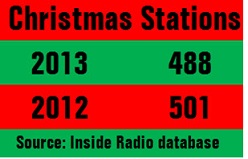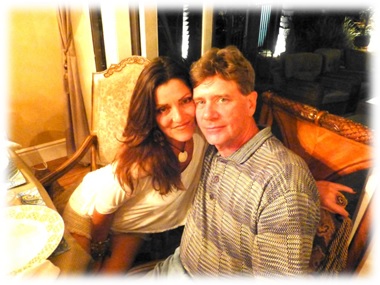For our second honoree in our “Radio’s Most Innovative” series, we are going back in time and possibly opening Pandora’s Box. Our intention is to honor the station that originated the All Christmas Music promotion; a bold innovation that, as evidenced by the chart below, has had a large and lasting impact on the radio industry.
Unfortunately, it’s not that simple. As we know, success has many fathers, and in this case, PDs, GMs, and consultants. So we turned to radio’s “Chief Factician,” Sean Ross, for help. And as it turns out, Sean wrote an investigative piece surrounding this mystery back in 2011 for RadioInfo. Leaving no stones, or wreaths, unturned as he tried to figure it all out, he talked to the main players in this drama. You can read Sean’s article here. What he found is that most of the arrows pointed to GM Jerry Ryan at KEZ (KESZ/Phoenix) as the very first to innovate All Christmas Music and make it a big success. Jerry’s story is truly about risk-taking – always a key to innovation success.
There is no definitive answer to who was technically first to go All Christmas Music. But as we at Jacobs Media have learned over the years with the Classic Rock format, while there were other stations that used that han dle off and before we came along, the key to innovation is achieving success, popularity, and impact with it. Through that filter, our best guess at this is that KEZ was very early to the party, and truly popularized All Christmas Music as a holiday institution. Today, hundreds of stations follow suit.
dle off and before we came along, the key to innovation is achieving success, popularity, and impact with it. Through that filter, our best guess at this is that KEZ was very early to the party, and truly popularized All Christmas Music as a holiday institution. Today, hundreds of stations follow suit.
Jerry Ryan, who now has his own commercial real estate enterprise in San Diego, was kind enough to answer our questions about the drama and debate surrounding going All Christmas Music on major FM Adult Contemporary station. As you’ll read, this was just one of the risks that Jerry and Bob Duffy took with this Phoenix station back in the ’90s. And much of what made this venture successful was having a powerful morning show behind it.
JM: What’s the backstory behind KEZ going All Christmas Music? Whose idea was it? Did you see it in research?
JR: There was actually a small AM station on the outskirts of Phoenix that went All Christmas Music in December probably back in 1989 / 1990. It never showed up in Arbitron but, after going All Christmas Music, we saw spikes among Women 25-54. So the only research we had was Arbitron.
KEZ was owned at that time by Duffy Broadcasting. Bob Duffy lived in Carefree, and we talked every day. There was no group; it was just the one station. Our competitors at the time were much larger companies – Pulitzer, EZ Communications, Bonneville was buying the Westinghouse Station KMEO, and Nationwide may have jumped into AC radio at that time as well. We knew we had to take calculated risks to win.
JM: What year did you officially first go All Christmas Music and what finally convinced you to try it? There couldn’t have been a consensus on the idea so what was the deciding factor?
JR: My thinking is that we went All Christmas Music in 1990 or 1991. It was worth the risk based on three factors: 1) We had the competitive advantage of our morning show. Beth and Bill could  push the button for All Christmas Music, (and) tell the audience what we were doing. They were an extraordinary morning show that gave us credibility. 2) If a small AM could pull Women 25-54 numbers, why couldn’t a full power FM enhance their ratings inside the demo? 3) We had to take risks to win. Our competitors could easily outspend us, we had to have people look at the dial, find us, and build an emotional attachment to our brand.
push the button for All Christmas Music, (and) tell the audience what we were doing. They were an extraordinary morning show that gave us credibility. 2) If a small AM could pull Women 25-54 numbers, why couldn’t a full power FM enhance their ratings inside the demo? 3) We had to take risks to win. Our competitors could easily outspend us, we had to have people look at the dial, find us, and build an emotional attachment to our brand.
Ultimately, the next year and in the years that followed, we started the compilation CDs with Christmas music, featuring the classic songs. We did that for several years kicking off the Christmas Music Marathon at The Biltmore Fashion Mall with a special Beth & Bill Broadcast from 9–noon the day after Thanksgiving.
JM: This innovation breaks many marketing rules – essentially changing formats at the end of the year. You’ve noted that Alan Burns and John Gehron both argued against it (as most consultants would). Why did you do it anyway?
JR: Ideas come before money. Our competitors were much bigger, but if we could execute our ideas better, we would have a chance to win. Christmas Music was just one of many ideas we tried. Some worked, some didn’t.
Prior to John, and Alan consulting us (both gave us terrific advice – they are two of the best minds in radio), we went through a few research companies that told us to just focus on midday music. Eventually, Bob (Duffy) and I gave up on the research companies, and focused on taking calculated risks to win.

For example, there’s our morning show. We were lucky to have Beth & Bill, who were fantastic, win the daypart for us in a big way. We developed a BIG FUN music category for them with over 500 songs not on an AC playlist they could use at any time, which eventually turned into three compilation CDs. We also carried Dr. Laura from 7-10 PM on a delayed basis when she was first starting (we should have kept that on longer), and we were the second FM to carry play-by-play sports with the Arizona Cardinals. Ron Chapman at KVIL was the first with the Cowboys. Programmers could learn a lot from studying Ron; he was a genius.
JM: Looking back on it, what was your biggest fear that first year?
JR: My feeling was it would work. If it was a mistake, we wouldn’t do it next year. The person who never made a mistake always takes orders from the one who has.
JM: What was the client reaction to KEZ going All Christmas Music and were you able to charge higher rates as the years went on?
JR: At first our competitors were all over the streets saying we changed format. We just went out to the ad community, and told them “No, it was NOT true.” It helped that Beth & Bill were phenomenal and that they believed in it. They gave us credibility and said it was special, which sold it to our audience. And over the years the rates and ratings continued to accelerate.
JM: Why aren’t there more innovations like All Christmas Music today?
JR: There are a lot of different ideas that terrestrial broadcasters could be doing. The key is finding different ideas that can create strong entertainment value that attach emotional bonds to the brand. Look outside of the “conventional wisdom.” Look at the shows that Public Radio has; look at all forms of audio entertainment.
JM: You’ve said that KEZ “wasn’t afraid to be different.” How can broadcasters cultivate that sort of spirit today?
JR: You have to learn how to take calculated risks. It is the secret to your career and to business. When you risk nothing, your risk of long term failure is ultimately much more significant.
Cultivating that spirit in the consolidated business of radio today shouldn’t be that hard. The bigger companies should try to create idea incubators in markets where they can afford to take risks. Duffy Broadcasting had just one station, (so) one wrong move and we could have irreparably hurt the company, but we had to try to win. Let me sum it up this way, You have to take risks in your career, and in your financial life. Warren Buffett is worth over $50 billion because he takes calculated risks.
Special thanks to Sean Ross for his analysis, and to Michael Harrison of RadioInfo.com for permission to use Sean’s article that first ran in November 2011.
INNOVATION QUOTE OF THE WEEK:
“If you want something new, you have to stop doing something old.” – Peter F. Drucker
More of Radio’s Most Innovative
- Radio’s Most Innovative: NPR One
- Radio’s Most Innovative: WTOP Digital
- Radio’s Most Innovative: Entercom Sacramento’s “Eat Farm To Fork” Initiative
- Radio’s Most Innovative: John Fullam/Greater Media Philly Innovation Challenge
- Radio’s Most Innovative: Radio.com’s Minimations
- For Radio, Will It Be Christmas In April (And Hopefully, May)? - April 21, 2025
- Media And Technology In 2025: Believe It Or Not! - April 18, 2025
- In Radio, You Just Never Know - April 17, 2025





Leave a Reply